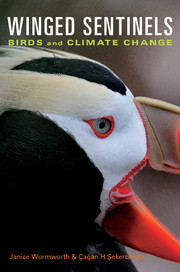Book contents
- Frontmatter
- CONTENTS
- ACKNOWLEDGEMENTS
- Introduction: The Free Advice of Birds
- Chapter 1 Phenology: Seasonal Timing and Mismatch
- Chapter 2 Migratory Birds Face Climate Turbulence
- Chapter 3 Range Shifts and Reshuffled Communities
- Chapter 4 Seabirds Herald Ocean Changes
- Chapter 5 Climate Change, Abundance and Extinction
- Chapter 6 Tropical Warming and Habitat Islands
- Chapter 7 Shifting Ground on Conservation
- NOTES
- INDEX
- PLATE SECTION
- PLATE SECTION
- PLATE SECTION
Chapter 2 - Migratory Birds Face Climate Turbulence
Published online by Cambridge University Press: 05 March 2012
- Frontmatter
- CONTENTS
- ACKNOWLEDGEMENTS
- Introduction: The Free Advice of Birds
- Chapter 1 Phenology: Seasonal Timing and Mismatch
- Chapter 2 Migratory Birds Face Climate Turbulence
- Chapter 3 Range Shifts and Reshuffled Communities
- Chapter 4 Seabirds Herald Ocean Changes
- Chapter 5 Climate Change, Abundance and Extinction
- Chapter 6 Tropical Warming and Habitat Islands
- Chapter 7 Shifting Ground on Conservation
- NOTES
- INDEX
- PLATE SECTION
- PLATE SECTION
- PLATE SECTION
Summary
Synchronised odysseys in a changing world
The extreme lifestyles of bar-tailed godwits suggest how demanding, time-sensitive schedules could make some migratory birds vulnerable to climate change. Each September in Christchurch, New Zealand, the cathedral's bells have traditionally rung for 30 minutes to welcome the first of these large wading shorebirds. A bit of celebration is called for, because some bar-tailed godwits migrate from Alaska in a single hop of more than 10000 kilometres – the longest non-stop flight recorded for a land bird. These avian endurance champions owe this feat to extraordinarily efficient physiology, abundant food and favourable southward winds.
After spending long Arctic summer days breeding, bar-tailed godwits gorge on worms and shellfish on the food-rich Yukon-Kuskokwim Delta mudflats. By departure time their hearts and flight muscles have enlarged, their blood has thickened to carry more oxygen, and their weight has doubled until roughly 55 per cent of their mass is fat, which is even more energy-efficient than high-octane automobile fuel. Their transformation from breeding machines to fat-fuelled flying machines complete, these godwits await favourable winds to boost them towards New Zealand.
From 2006 to 2008, satellite transmitters allowed a captivated human audience to follow their formerly unverifiable movements, confirming suspicions that some of these marathon migrants complete their journey without resting, to cover at least 1000 kilometres a day. Exactly how these godwits fly continuously without food or water for about nine days is a question that challenges our understanding of vertebrate physiology.
- Type
- Chapter
- Information
- Winged SentinelsBirds and Climate Change, pp. 33 - 62Publisher: Cambridge University PressPrint publication year: 2011

